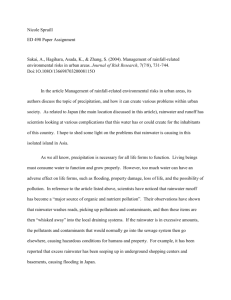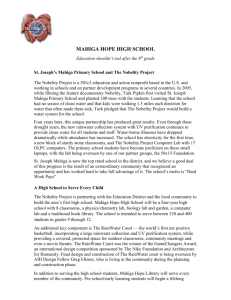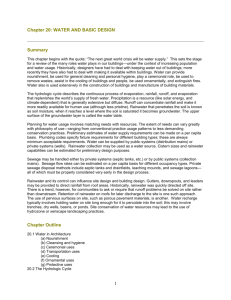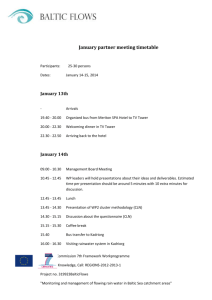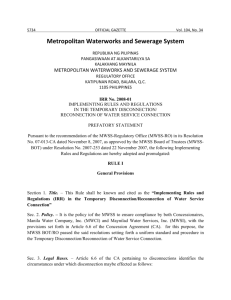Why are we doing the FLOOD resource
advertisement
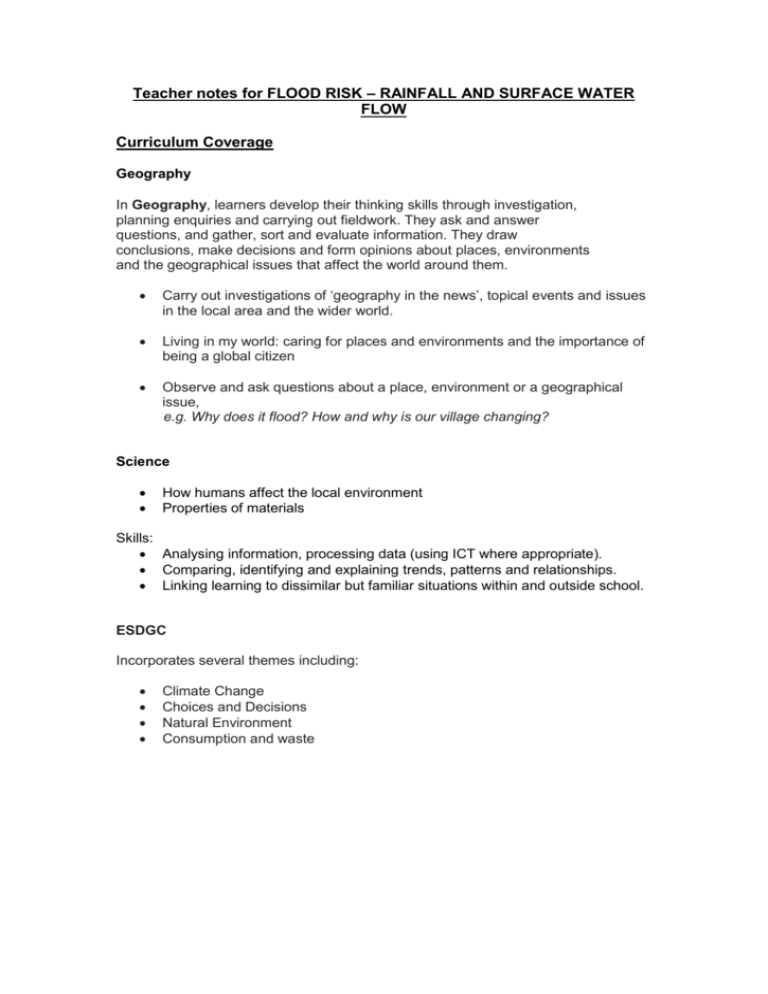
Teacher notes for FLOOD RISK – RAINFALL AND SURFACE WATER FLOW Curriculum Coverage Geography In Geography, learners develop their thinking skills through investigation, planning enquiries and carrying out fieldwork. They ask and answer questions, and gather, sort and evaluate information. They draw conclusions, make decisions and form opinions about places, environments and the geographical issues that affect the world around them. Carry out investigations of ‘geography in the news’, topical events and issues in the local area and the wider world. Living in my world: caring for places and environments and the importance of being a global citizen Observe and ask questions about a place, environment or a geographical issue, e.g. Why does it flood? How and why is our village changing? Science How humans affect the local environment Properties of materials Skills: Analysing information, processing data (using ICT where appropriate). Comparing, identifying and explaining trends, patterns and relationships. Linking learning to dissimilar but familiar situations within and outside school. ESDGC Incorporates several themes including: Climate Change Choices and Decisions Natural Environment Consumption and waste Background for teachers – from DWR CYMRU The floods that hit the UK in the summer of 2007 were unprecedented on all levels. The period from May to July was the wettest since national records began in 1766, 55,000 properties were flooded and 13 people died. The estimated cost of direct damage caused by the flooding is approximately £3 billion. It has been estimated that two-thirds of the homes flooded in 2007 were flooded by surface water i.e. rainfall that runs from impermeable areas such as roofs, highways and driveways into the sewerage system. This flooding was an exceptional event but it is now widely accepted that climate change will increase both the frequency and intensity of rainfall, and with the growth of built-up areas (known as impermeable area creep) preventing water from soaking into the ground as nature intended, more flooding and more pollution getting into the rivers and seas will occur. In order to mitigate these effects of climate change, to counter impermeable area creep whilst also encouraging recreational and conservation opportunities, Dwr Cymru Welsh Water (DCWW) have recognised that surface water needs to be managed in an integrated and sustainable way and that it should be returned to the ground and open water courses at the earliest opportunity and have commissioned the development of a long-term strategy. Part of the strategy will promote the use of Sustainable Drainage Systems (SuDS) which are systems that when in the urban environment, deal with surface water runoff close to where rain falls, protect or enhance water quality, and are sympathetic to the environmental setting and the needs of the local community. They can also provide a habitat for wildlife in urban watercourses and encourages natural groundwater recharge. Resource overview This resource can be used to help demonstrate to pupils how human impact on their local environment can lead to undesirable effects. It also breaks the stereotype that only houses next to rivers are subject to flooding as often presented in the news. Simulation The simulation shows a fictitious street in Wales – Cleardrain Lane. The lane is sloped with seven houses. The top six houses can all be selected so that pupils can change aspects of each which increase / decrease the surface water flow from each residence. To help inform pupil choices, the simulation comes with a set of resident cards. Pupils can read the resident information for each house and make changes on the simulation to see the impact of those lifestyle choices. For the roof, pupils can select to have a simplified version of ‘rainwater disconnection’ technology fitted for the whole roof (leading to 0% run off), half of the roof (leading to 50% run off) or leave the roof as it is (leading to 100% run off) – see below for more information on rainwater disconnection. For the front and back gardens, pupils can select to have either all grass (0% run off), all patio / driveway (100% run off) or differing combinations of both. Once the choices are inputted, an overall flow (in litres per second) will be calculated for each house. These are indicated on screen via flow bars so pupils can compare the houses. A total flow is worked out by the simulation and users will find out whether their choices lead to flooding problems at the seventh house. There are options for pupils to study the impact of their choices depending on the severity of storms (from typical yearly storms up to ‘1 in 30 year’ storms) and also to compare figures using predictive models for 2050 and 2080. In essence, the simulation is completely open and pupils can enter worst case / best case scenarios and even base the houses on their own to create debate and discussion around lifestyles, choices and decisions in light of future climate change. What is ‘rainwater disconnection’? Briefly, disconnection means disconnecting your rainwater drainpipes from the sewerage system so that the rainwater runoff flows to another receptor such as another part of the garden or to a collection / storage tank (such as rainwater harvesting tanks or waterbutts) or a watercourse. ‘Rainwater harvesting’ is one form of rainwater disconnection. In reality, a home would need a range of disconnection measures to reduce significant surface water flows to the sewerage system (disconnection not only applies to rainwater downpipes but also paved areas such as patios and driveways). Rainwater Harvesting Animation You can look at one way of rainwater disconnection by using the animation supplied by Northavon Pumps (for online educational use only). The short film shows how water is captured, stored and then used for various jobs around the home. This increases water efficiency and also has the added benefit of reducing a small amount of flow to the sewers). Powerpoint Presentations These 3 presentations are based around existing Eco-schools resources (authored by Rhys Bebb) and introduce the concept of flooding due to surface water flow and lack of care to existing drain networks. They are ready to be used or can easily be adapted to fit your own needs / ability range. Surface Flow Graphs The two surface flow graphs have been set up to show a high rainfall intensity falling on an area that is 100% paved area compared with 100% grass. The only variable is the type of surface. Timing and rainfall levels are the same in each case. They are extreme examples of the types of hydrographs that you could expect into the drainage network to demonstrate that paving over a grassed area will produce a far higher peak flow (which causes flooding). The purpose of these graphs is again to spark discussion and comparison. The ‘paved area’ graph shows a much steeper increase in flow levels following the short but intense rainfall (as nearly all the water flows straight off into the drains in a very short time) leading to a large amount of water reaching the drains at the same time. The ‘grassed area’ graph shows a much more gradual flow but it is also important to note the amount of water flowing on each graph as far less water flows from the grass (in fact, almost nothing as most of it drains into the ground).
